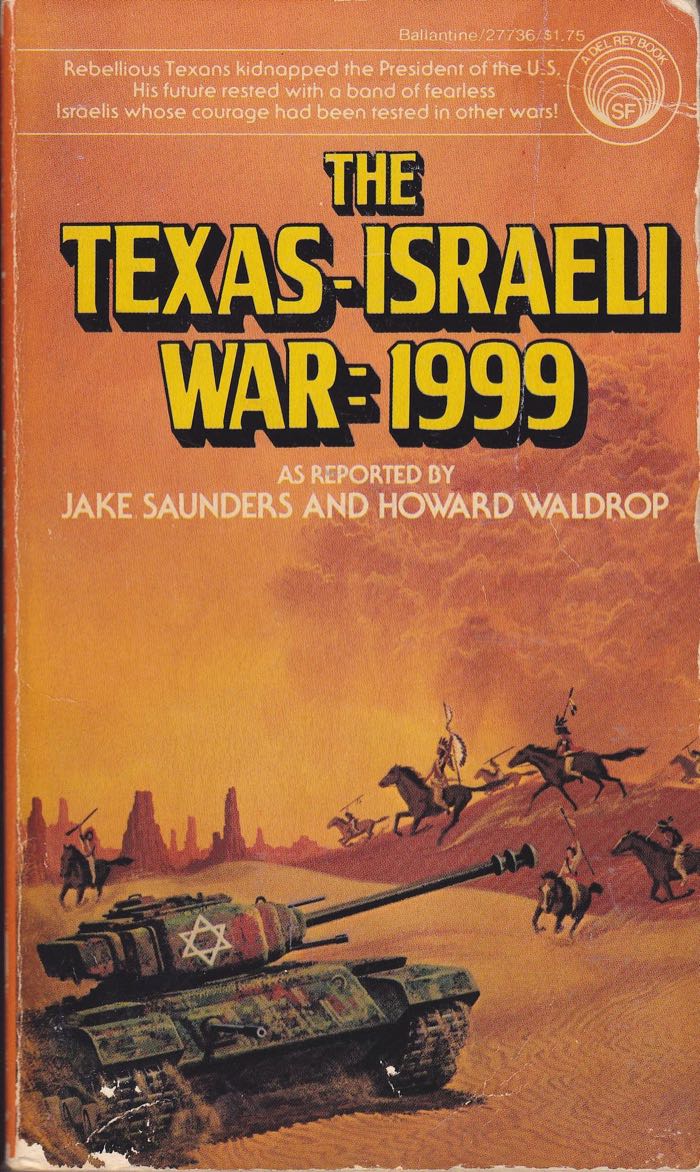The Texas-Israeli War: 1999
Reviewed date: 2004 Dec 24
Rating: 2
209 pages
In 1992 Irish terrorists contaminated England's water supply with a variant of LSD. Irrational British leaders launched a nuclear attack against Ireland and against her allies, China and South Africa. China retaliated against the British commonwealth. Both the US and the USSR tried to remain neutral, but a Chinese missile bound for Canada strayed off course into the US, ending her neutrality, and a Chinese land invasion of Russia brought the USSR into the war. With the Americans and the Russians fighting a common enemy, the Arab states could not count on Russian backing in a war against Israel. Thus, mercifully, Israel alone of all nuclear powers was wholly spared during WWIII.
Seven years later Israel is struggling with overpopulation. Israelis eager for land hire themselves out as mercenaries to the armies of the United States and of the Republic of Texas. The Texas-Israeli War: 1999 follows a group of Israeli and American soldiers as they carry out a secret mission: penetrate Texan defenses and rescue the kidnapped President of the United States. The action starts at the Texas-Oklahoma border and ends up at Ft. Deaf Smith in Crystal City, next to the Mexican border.
The Texas-Israeli War: 1999 is dull. Plainly put, the authors never offered a satisfactory or compelling reason why this mission had to occur. The motivations of the Israeli mercenaries is unclear--why must they fight in order to get land? One would think that, with 90% of the world's population dead in WWIII, that there would be plenty of land for everyone. But apparently the land is only available to those who fight in foreign armies. Yeah right.
Further, the book consists almost entirely of descriptions of warfare. Strategy and tactics make good war manuals but poor novels. Even the token attempt at a love interest is a haphazardly and shoddy construction. The book is just plain boring.
Worse than that, the book is wrong. The Israelis, Americans, and Texans--even the ones who lived there--all refer to the Dallas-Ft. Worth area as Dalworthington. Uh huh. Nobody calls it Dalworthington. Locals call it the Metroplex. Outsiders sometimes call it DFW, but us locals know that DFW means the airport, not the whole metropolitan area. Now, there is a city called Dalworthington Gardens, but it's an unpretentious little town of 2,000 nestled between Ft. Worth and Dallas, and just south of Arlington. But seriously, nobody calls this whole place Dalworthington.
[Update 8/7/2018: I wrote the following criticism when I first reviewed the book. I've been feeling guilty ever since. It's not fair to criticize the authors simply because the route of the highway was changed after they wrote the story. I was just upset that the book confused me. My criticism was unfair and I withdraw it, but I'm leaving it here for reference.]
The authors made one other mistake: there is a reference to the junction of I-20 and I-30 east of Dallas, in the Mesquite area. But oops, I-20 and I-30 don't meet anywhere near Mesquite--in fact they only meet west of Ft. Worth. Now, in the defense of the authors, I must say that until 1971, I-20 and I-30 did meet in the Mesquite area; since 1971 I-20 has been rerouted so it no longer meets I-30 until west of Ft. Worth. But The Texas-Israeli War: 1999 was published in 1974, by which time the route of I-20 should have already been changed. And if it hadn't, at least by that time the plans were already public--I am looking right now at a 1971 Dallas map that shows the new route of highway 20--so there is no excuse for the authors not to have noted this fact and written their book accordingly. Parts of the story were published earlier in Galaxy Magazine, so maybe those parts were written before 1971, but any inconsistencies should have been corrected before it went to book form. This is a mistake that should have been caught by the authors and by the copy editors. For shame!
The Texas-Israeli War: 1999 scores a two out of five.
